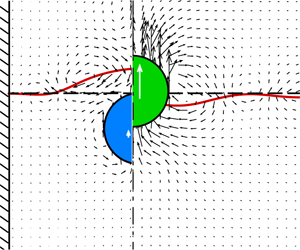Article contents
Submersion of impacting spheres at low Bond and Weber numbers owing to a confined pool
Published online by Cambridge University Press: 05 December 2019
Abstract

We numerically investigate the mechanism resulting in fate change of a hydrophobic sphere impacting onto a confined pool, that is, at the same impact speed, it does not submerge in a wide pool but does in a narrow pool. We find that the reflection of the impact-induced gravity-capillary waves from the pool boundary is responsible for this phenomenon. In particular, the return of the wave to the symmetry axis may coincide with the rising of the impacting sphere to the water surface, which corresponds to the critical conditions of the fate change. Moreover, for the spheres at the onset of submersion in a wide pool, our analysis suggests that this scenario also accounts for an interesting observation in the numerical simulations. That is, the effective pool size  $S_{c}$, beyond which the submersion of impacting spheres is no longer affected by the pool size
$S_{c}$, beyond which the submersion of impacting spheres is no longer affected by the pool size  $S$, is mainly dependent on the sphere diameter, no matter whether the surface waves are the capillary or gravity waves. For
$S$, is mainly dependent on the sphere diameter, no matter whether the surface waves are the capillary or gravity waves. For  $S<S_{c}$, two important pool sizes (
$S<S_{c}$, two important pool sizes ( $S_{w,1}$ and
$S_{w,1}$ and  $S_{w,2}$, and
$S_{w,2}$, and  $S_{w,2}\geqslant S_{w,1}$) are identified at the same impact speed, and the sphere submersion takes place at
$S_{w,2}\geqslant S_{w,1}$) are identified at the same impact speed, and the sphere submersion takes place at  $S_{w,1}\leqslant S\leqslant S_{w,2}$. Based on the flow features identified in simulations, a scaling law is proposed to correlate the Weber number and Bond number with
$S_{w,1}\leqslant S\leqslant S_{w,2}$. Based on the flow features identified in simulations, a scaling law is proposed to correlate the Weber number and Bond number with  $S_{w}$. The theoretical prediction is shown to agree well with the numerical results.
$S_{w}$. The theoretical prediction is shown to agree well with the numerical results.
- Type
- JFM Papers
- Information
- Copyright
- © 2019 Cambridge University Press
References
- 11
- Cited by



